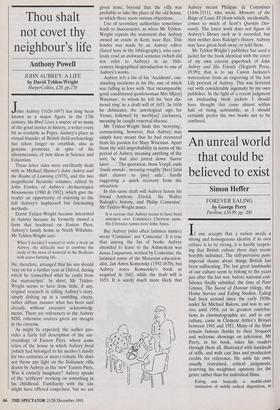Thou shalt not covet thy neighbour's life
Anthony Powell
JOHN AUBREY: A LIFE by David Tylden-Wright HarperCollins, £20, pp.270 John Aubrey (1626-1697) has long been known as a major figure in the 17th century, his Brief Lives a source of so many of the good stories in history, a writer every bit as readable as Pepys. Aubrey's place as virtual founder of British field-archaeology has taken longer to establish, also as genuine promoter, in spite of his idiosyncrasies, of new ideas in Science and Education.
These latter sides were excellently dealt with in Michael Hunter's John Aubrey and the Realm of Learning (1975), and the two magnificent facsimile volumes, edited by John Fowles, of Aubrey's Archaeologica Monumenta (1980 & 1982), which give the reader an opportunity of enjoying to the full Aubrey's haphazard but fascinating methods.
David Tylden-Wright became interested in Aubrey because he formerly owned a farm that bordered on Easton Piers, Aubrey's family home in North Wiltshire. Mr Tylden-Wright says:
When I decided I wanted to write a book on Aubrey, the difficulty was to combine the study of the mass of material in the Bodleian with active farming life.
He, therefore, arranged that his son should `stay on for a further year at Oxford, during which he transcribed what he could from the manuscripts'. In short, Mr Tyiden- Wright seems to have done little, if any, original research in telling Aubrey's story, simply dishing up in a rambling, chatty, rather diffuse manner what has been said already, without excessive acknowledg- ments. There are references to the Aubrey MSS, otherwise sources given are meagre in the extreme.
As might be expected, the author pro- vides a fairly full description of the sur- roundings of Easton Piers, where some relics of the house in which Aubrey lived (which had belonged to his mother's family for two centuries or more) remain. He does not throw any light on the Italianate villa drawn by Aubrey as the 'new' Easton Piers. Was it entirely imaginary? Aubrey speaks of the 'artificers' working on something in his childhood. Familiarity with the site might have offered conjecture, but we are given none, beyond that the villa was probably to take the place of the old house, to which there seem various objections.
Use of secondary authorities sometimes leads to inaccuracies, as when Mr Tylden- Wright repeats the statement that Aubrey owned an estate in Kent, near Rye. This howler was made by an Aubrey editor (listed here in the bibliography), who care- lessly read an awkward sentence (which did not refer to Aubrey) in an 18th- century biographical introduction to one of Aubrey's works.
Aubrey left a list of his 'Accidents', out- standing incidents in his life, one of which was falling in love with 'that incomparable good conditioned gentlewoman Mrs M[ary] Wiseman', to whom he left his 'best dia- mond ring' in a draft will of 1653. In 1656 he delineates the astrological sign for Venus, followed by `morb[us]' (sickness), meaning he caught venereal disease.
Mr Tylden-Wright finds this 'worrying', commenting, however, that Aubrey may simply have meant that he had recovered from his passion for Mary Wiseman. Apart from the wild improbability in terms of the period of Aubrey meaning anything of the sort, he had also jotted down `haeret lateri . .' The quotation, from Vergil, ends `letalis arundo', meaning roughly `[her] fatal dart cleaves to [my] side'; hardly suggesting a quick recovery from the attraction.
In this same draft will Aubrey leaves his friend Anthony Ettrick 'Sir Walter Raleigh's history, and Philip Comenius'. Mr Tylden-Wright notes:
It is curious that Aubrey seems to have been mistaken over Cominius's Christian name. His Christian names were John Amos.
But Aubrey (who often latinises names) wrote 'Cominius', not 'Comenius'. It is true that among the list of books Aubrey intended to leave to the Ashmolean was Janua Linguarum, written by Comenius, the latinised name of the Moravian education- alist, Jan Amos Komensky (1592-1670), but Aubrey notes Komensky's book as acquired in 1665, while the draft will is 1653. It is surely much more likely that
Aubrey meant Philippe de Commines (1446-1511), who wrote Memoirs of the Reign of Louis XI (from which, incidentally, comes so much of Scott's Quentin Dur- ward). The latter work does not figure in Aubrey's library such as is recorded, but then neither does Raleigh's History. Aubrey may have given both away, or sold them.
Mr Tylden-Wright's publisher has used a jacket for the book identical with the cover of my own current paperback of John Aubrey and His Friends (Hogarth Press, £9.99); that is to say Canon Jackson's watercolour from an engraving of the lost Lily portrait of Aubrey. This was ferreted out with considerable ingenuity by my own publisher. In the light of a recent judgment on misleading book jackets I should have thought this came almost within hail of being actionable, as I should certainly prefer the two books not to be confused.










































































































 Previous page
Previous page